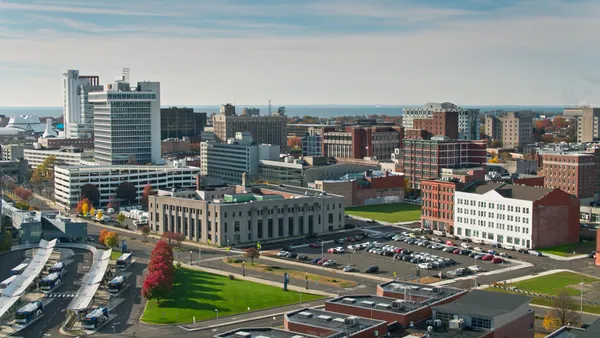Dive Brief:
- A new report from the Milken Institute's Center for the Future of Aging found U.S. cities are slow to craft policies to accommodate older people, even as a growing share of aging people live in metropolitan areas.
- Currently, about eight in 10 U.S. residents 65 and older live in metropolitan areas, and adults over 60 are expected to account for about half of urban consumption growth by 2030. The report says that makes cities "ground zero for the demographic shift" of an older population.
- Based on interviews with experts in urban planning, public policy and aging, the report finds the most important policy measure for older residents is safe and affordable housing. Cities are also encouraged to design walkable and dense neighborhoods that better serve seniors, and expand access to health care.
Dive Insight:
The report says that many American cities aren’t doing enough to prepare for the needs of an aging population, including a failure to acknowledge "the interconnection between their aging communities and their cities’ economic health and sustainability." That, said report co-author and Center for the Future of Aging Associate Director Caroline Servat, leaves governments at risk for older Americans falling behind and neglecting policies that can help all residents.
"From local workforce policies that enable flexible work arrangements, to home sharing models that offer creative solutions to the affordability crunch in housing markets across the country, Age-Forward solutions hinge on a multigenerational approach to inform how cities grow, build, and care in the future," Servat said in an email. An Age-Forward perspective, she added, "fosters intergenerational engagement and opportunities."
There is some progress being made. Several cities have passed age-friendly strategic plans, or enacted policies aimed at housing affordability (by age 65, approximately 40% of middle-class people fall into poverty or near-poverty, according to the report). Washington, DC, for example, has permitted accessory dwelling units to allow older people to stay in small homes on family’s property and has constructed below-market-rate housing for older residents. The Gensler Research Institute has proposed a “BoomTown” model that would convert entire neighborhoods to age-friendly communities as an alternative to retirement communities.
And trends like new urbanism, complete streets and Vision Zero programs are also strategies that will help seniors, the report finds. One area that could require more attention, Servat said, is technology, as cities integrate more connected infrastructure and digital tools.
Even though such strategies can help older Americans, Servat noted that it is "critical for cities to cultivate cross-sector programs to bridge the digital literacy gap for lower-income older adults and invest in the development of open data tools to help older adults navigate tech-based challenges."











